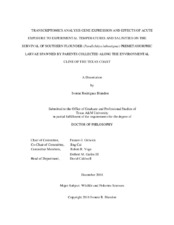| dc.contributor.advisor | Gelwick, Frances I. | |
| dc.creator | Blandon, Ivonne Rodriguez | |
| dc.date.accessioned | 2019-01-23T22:05:09Z | |
| dc.date.available | 2020-12-01T07:32:47Z | |
| dc.date.created | 2018-12 | |
| dc.date.issued | 2018-12-10 | |
| dc.date.submitted | December 2018 | |
| dc.identifier.uri | https://hdl.handle.net/1969.1/174630 | |
| dc.description.abstract | Southern flounder (Paralichthys lethostigma) provides important commercial and recreational fisheries opportunities on the Texas coast. The economic impact of this fishery is negatively affected by recent declines in harvest throughout the geographic range of this species. Environmental variables that may be important determinants of Southern flounder abundance and fishery productivity include freshwater inflows, extent and type of the nursery habitat and changes in temperature regimes related to climate change. Despite progressive harvest regulations to manage the population decline and protect the adult spawning migration to the Gulf of Mexico, the Southern flounder population has not recovered to its historical level. The Texas Parks and Wildlife Department is implementing a stock enhancement program for Southern flounder to supplement natural populations on the Texas bays. A critical phase of the program is to validate at large scale the larval and juvenile production protocols available for Southern flounder to optimize physical environmental parameters that influence survival during larval rearing. Temperature and salinity are two ubiquitous abiotic factors that influence all biological functions of these two early life history stages and survival. I exposed Southern flounder eggs and premetamorphic larvae to different temperature and salinities found on the environmental cline of the Texas coast to evaluate the effect of these conditions on survival of individuals spawned by broodstock collected from different environments of coastal Texas. RNA next generation sequencing was used to generate more than 29,000 sequences that were assembled in a de novo transcriptome.
Temperature was the most important factor affecting the survival of Southern flounder at these two stages of development. Synergy between temperature, salinity, and site of collection of the parents also played a role in fish survival in response to the temperature and salinity challenges.
From the sequences, 96% were mapped and used to identify proteins, genes and biological gene functions. The number of up-regulated genes and gene expression was higher for temperatures and salinity in Sabine and Aransas fish than in Galveston. | en |
| dc.format.mimetype | application/pdf | |
| dc.language.iso | en | |
| dc.subject | Southern Flounder | en |
| dc.subject | Transcriptome | en |
| dc.subject | gene expression | en |
| dc.title | Transcriptomics Analysis Gene Expression and Effects of Acute Exposure to Experimental Temperatures and Salinities on the Survival of Southern Flounder (Paralichthys lethostigma) Premetamorphic Larvae Spawned by Parents Collected Along the Environmental Cline of the Texas Coast | en |
| dc.type | Thesis | en |
| thesis.degree.department | Wildlife and Fisheries Sciences | en |
| thesis.degree.discipline | Wildlife and Fisheries Sciences | en |
| thesis.degree.grantor | Texas A & M University | en |
| thesis.degree.name | Doctor of Philosophy | en |
| thesis.degree.level | Doctoral | en |
| dc.contributor.committeeMember | Cai, James | |
| dc.contributor.committeeMember | Gatlin III, Delbert M | |
| dc.contributor.committeeMember | Vega, Robert R | |
| dc.type.material | text | en |
| dc.date.updated | 2019-01-23T22:05:09Z | |
| local.embargo.terms | 2020-12-01 | |
| local.etdauthor.orcid | 0000-0002-6683-0897 | |


